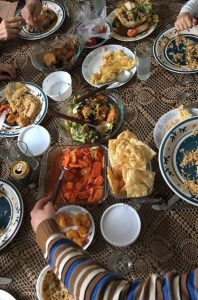
For this assignment, I decided to go to my aunt and uncle’s home for dinner in an effort to further understand the cultural significance and uses of their dining table. Although I really only wanted to use an interview as an anthropological method my aunt Beatriz insisted that I stay and eat dinner with them making this study also use the anthropological method of a participant observer. It was relatively easy to establish who I was, given that this was my family and I was interviewing my aunt for this assignment. However, it was a little harder to convey why I was conducting this study. After many attempts to explain that a kitchen table could serve as a cultural artifact that can be used to shed light on the lives and practices of particular people/cultures, my aunt understood the purpose of the study and we could continue with the interview.
The reason I chose my aunt and uncle’s home/dining table is because they are a very traditional Peruvian family. I am very intrigued by their life because it is very different from mine, my aunt and uncle have been married for 45 years, have three adult daughters who have children of their own. Traditionally in Peru, it is very custom to live at home with your parents until you get married (which could be as late as 30+ nowadays). It is also common for the wife of the household to be a stay-at-home mom/homemaker and for the husband of the household to work. Although, my aunt and uncle emigrated from Peru to the U.S. they were still able to maintain these cultural norms, unlike my mother and immediate family who have adapted more to the fast-paced life of the U.S. My uncle and aunt also live with their 2 younger daughters who are not married and are in their late 20’s and early 30’s. Additionally, I am interested in their dining table because it is an actual art piece custom made from old wooden doors from Peru. This was very exciting to me because the table was made to serve as a decorative piece with many functions and it was genuinely a Peruvian table in a Peruvian household.
As mentioned, before I chose the anthropological methods of interview and participant-observer. I fell into the participant-observer role because my aunt instead that I stay for dinner and I felt the interview would give me a good perspective on what they use their dining table for on a day to day basis. Throughout the interview, I learned many things about the use of the kitchen table. I asked about the use of the table that did not include eating and asked my aunt to give me a rundown of their daily life. I learned that my aunt purposefully wanted the table to serve as an art piece because when no one is using it would take up space and she wanted it to still be beautiful while functional. Additionally, she wanted the table to remind her of home, which is Peru and she actually had the front doors of her home in Peru taken down to make part of the dining table. My aunt also mentioned that every day before dinner time, it is very typical for my cousins and uncle to come home from their jobs and meet at the dinner table to chat about their day. The table is usually where they first get together to decompress from their busy days typically over some tea or coffee. Then around 8 or so my aunt will serve dinner on the table and everyone usually eats for about an hour or so and most of the meals would be traditionally Peruvian dishes such as ceviche, lomo saltado, papa la huancaina, and aji de gallina. After this usually everyone helps in the clean-up process and serves themselves either a glass of wine, tea, or coffee traditionally a café con leche (which is mostly milk). My aunt also mentioned that the table is used for homework throughout the day and as well as any computer work that people may have. Additionally, I learned that my aunt usually uses the dining table when sewing or making clothing, pillows, and blankets.
Unfortunately, I was not there to witness all these different uses of the dining table. However, I was able to enjoy a traditional meal of Peruvian Chifa which is Asian style Peruvian cuisine. We had fried rice, a wonton like dish, salad, sweet potato, fried shrimp, etc. Interestingly enough my aunt and I had our interview before dinner right on the dining table. After dinner, I helped my aunt clean up and we talked more at the table over some coffee about my life/schooling. It was interesting to see and learn about all the different functions a dining table could serve. In particular, I found that a dining table could serve as a place for meetings, communal workspace, eating space, a needlework station, and even for classroom interviews! I found that the table brought people together and helped support people in their work and other life endeavors that do not only include eating. Without the table, many of these family interactions would not happen in the same way and I do think that it could contribute to carrying cultural traditions through generations and possibly strengthening family ties.

Francesca, solid response to the essay prompt. You’ve answered all the five questions raised in the prompt. Two areas I encourage you to work on in the future are working with course materials, and building strong connection between class and your experience. These areas are of course closely related. You can refer to our evaluation rubric for details, but simply put, I would very much like to see you use course texts and inclass discussions to bear upon your discussions in the paper. On the whole, well done.